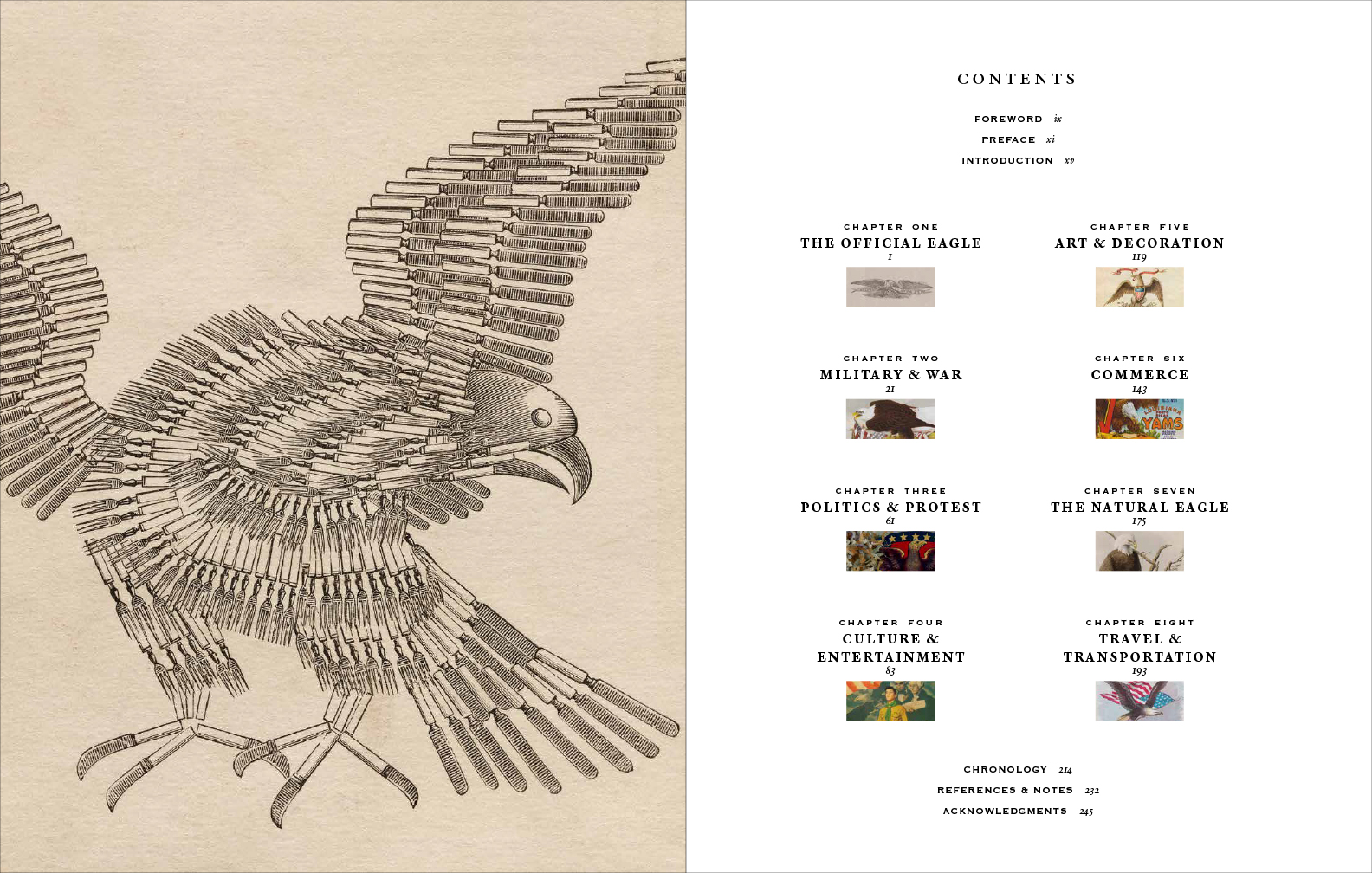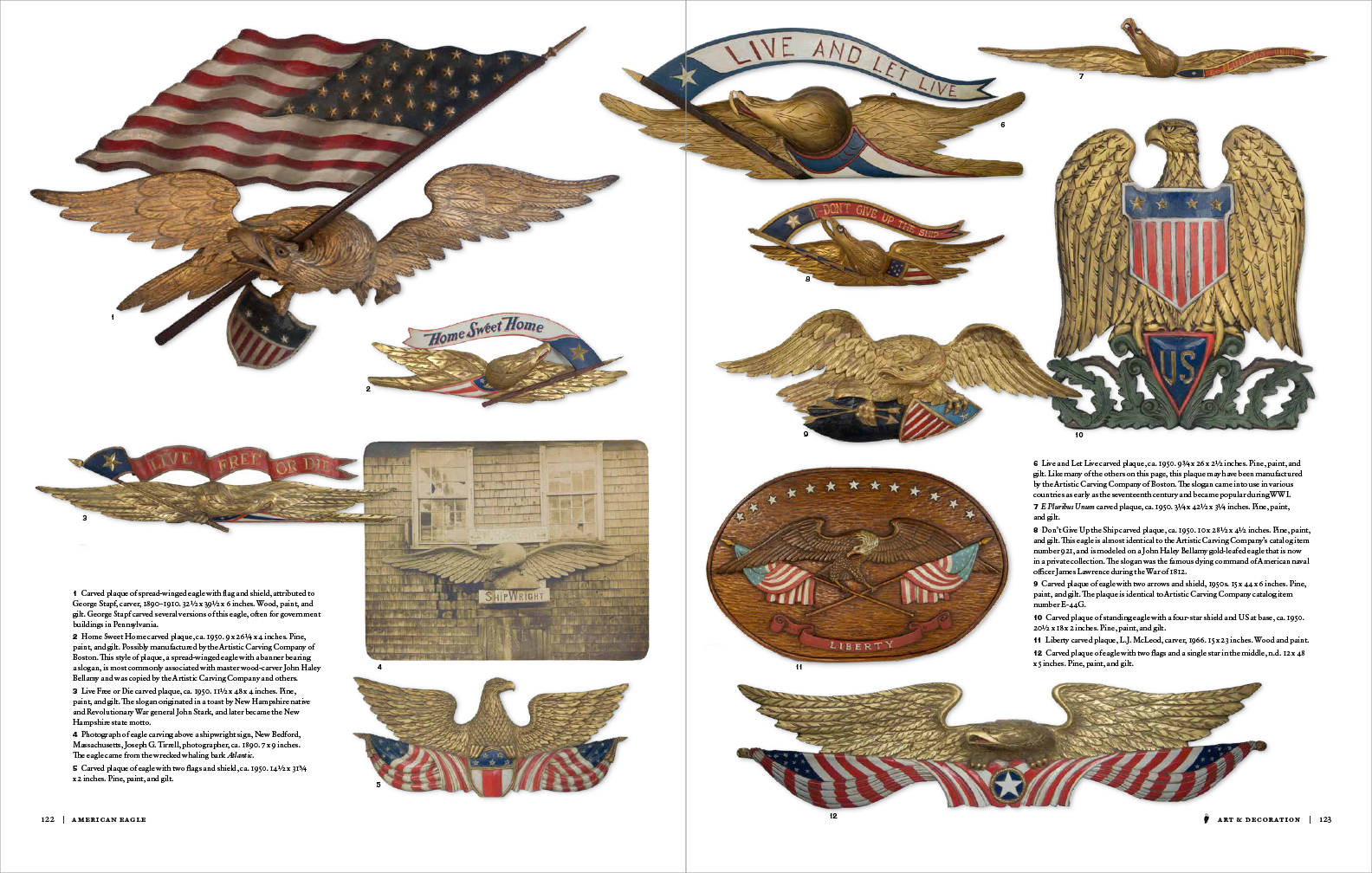New Book
A bold expression of a fledgling republic’s aspirations and bravado, the American bald eagle has been designed, drawn, illustrated, stamped, engraved, painted, sculpted, carved, photographed, and etched by thousands of artists and artisans since 1782, when it first appeared as the central figure on the Great Seal of the United States.
As America’s most versatile emblem, the eagle emanates confidence during peace and prosperity, and strength during crisis and war; as a North American native species it exemplifies nature’s grandeur and the advance of conservation. In all, the bald eagle is a stirring national symbol made all the more vibrant by its indisputable dominion in the sky.
This visual survey explores the eagle in American life through an array of objects in virtually every imaginable shape, size, and medium. Among them are a brass button from one of George Washington’s presidential inaugurations, original prints by John James Audubon and Andy Warhol, a Civil War Bowie knife, and a rare children’s bank from 1910.
Gathered here for the first time, these objects chart the bald eagle’s appearance in government, the military, politics, commerce, travel, art and culture, and nature. Descriptive captions provide physical details and contextual information, and an annotated chronology supplies a comprehensive, illustrated timeline of the bald eagle as an American icon.
A remarkable book that represents American culture, politics, and history, American Eagle will be the definitive source of this national icon for generations to come.
American Eagle: A Visual History of Our National Emblem
By Preston Cook
Foreword by Rolf Thompson, Executive Director, National Eagle Center
Publisher: Goff Books, an imprint of ORO Editions
Size: 11” x 14” Portrait
Pages: 264
Binding: Hardbound
Publication Date: April 2019
Price: $75.00
ISBN: 978-1-941806-28-9
Order the Book
Available wherever books are sold.
To have the book signed by the author:
Please order the book through the National Eagle Center here.
Sales of the book through the National Eagle Center will support the development of the museum.
Preview
A Selection of Entries from the Chronology in American Eagle: A Visual History of Our National Emblem
1782 Charles Thomson, secretary of the Continental Congress, is given the task of creating the final great seal design. After reviewing the reports and drawings from the three committees, Thomson gave the American bald eagle its prominent position on the obverse of the seal. It grasps the symbols of war and peace in its talons and has a chevroned shield on its breast. The scroll in its beak reads E pluribus unum – out of many, one. Thomson specified that it be an “American Eagle on the wing & rising proper.” Regarding his design as preliminary, Thomson gave his drawing and description to consultant William Barton to refine. Barton eliminated the chevrons on the shield and substituted thirteen vertical stripes, alternating red and white with a blue upper shield. He also changed the eagle from “on the wing & rising” to the “displayed” position, and specified that there should be thirteen arrows in the bird’s left talons and thirteen stars over the head of the eagle. Thomson submitted the revised design to Congress.
1782 In June Congress adopts the revised great seal design. By September the seal was in Secretary Thomson’s custody in Philadelphia, and he likely arranged for the engraving of the brass die (measuring 2 5⁄16 inches in diameter) and the acquisition of a press. The design of the Great Seal of the United States would change over time, and the eagle transformed from its scrawny beginnings to a more realistic bird.
1782 NOTE The year the great seal was adopted marks the beginning of the general acceptance of the bald eagle as a national icon, and its use in all aspects of American life leads many to believe that the bald eagle is the official national bird. Yet no action has ever been taken by Congress or by a president to formally recognize the eagle. In fact, only in recent history have Congress and the president designated specific natural symbols for the country: the rose was adopted as the national flower in 1986; the oak as the national tree in 2004; and the bison was proposed as the national mammal in 2013.
1784 In a letter to his daughter, Sarah Bache, Benjamin Franklin writes, “For my own part, I wish the bald eagle had not been chosen as the representative of our country.” The statement appears in the context of a lengthy criticism of the hereditary Society of the Cincinnati, which uses the eagle as its insignia, as an organization promoting an American nobility. In the same section Franklin humorously characterizes the comparative merits of the turkey. The letter was written after the great seal was created, and does not support the popular belief that Franklin advocated for the turkey on the great seal rather than the eagle.
1784 The four-page Hartford, Connecticut, American Mercury newspaper uses a woodcut rendition of the great seal on its first issue’s masthead. Founded by Joel Barlow and Elisha Babcock, the American Mercury was a weekly with a reputation for outspokenness. It was a leading reform publication, advocating especially for legal equality for all religious sects.
1832 The eagle insignia for the rank of army colonel – an eagle based on the great seal but with extended wings and no scroll in its beak – is made official. US Navy, Coast Guard, Public Health Service, and National Oceanic and Atmospheric Administration captains also use eagle insignia to designate rank. Full colonels are referred to as bird colonels, and “Is the bald eagle in?” is used when asking for a captain in the navy.
1857 McGuffey’s New Sixth Eclectic Reader includes a Scottish tale, “The Eagle’s Nest,” about an infant carried away by a golden eagle. Numerous stories over the years tell of babies and children carried off by eagles. The most famous may be the 1868 eagle abduction of an eight-year-old boy in Mississippi, with versions in disagreement about whether the boy was recovered. While it is true that eagles have attacked children and adults, a bald or golden eagle’s lifting capacity is approximately four pounds, making the lifting of even an infant virtually impossible. Yet the myth persists. In December 2012, design students in Montreal produced a prank video of a large bird swooping down and picking up a child in a local park – it received more than two million views on YouTube.
1911 The Boy Scouts of America designate Eagle Scout as its highest award and rank. Arthur Rose Eldred became the first Eagle Scout in 1912, and since then more than two million scouts have achieved the rank. Famous Eagle Scouts include Neil Armstrong, Justice Stephen Breyer, Lawrence Ferlinghetti, Gerald R. Ford, Steven Spielberg, and Wallace Stegner.
1942 The Screaming Eagles 101st Airborne Division is activated at Camp Claiborne, Louisiana, on August 16. Its first commander, Major General William C. Lee, noted that the division had no history at that point, but it had a “rendezvous with destiny.” “Our badge is the great American eagle. This is a fitting emblem for a division that will crush its enemies by falling upon them like a thunderbolt from the skies.” The Screaming Eagles were the first Allied troops in occupied France in June 1944.
1959 American artist Robert Rauschenberg creates one of his most famous works, Canyon, a three-dimensional multimedia collage, or “combine,” the centerpiece of which is a taxidermied bald eagle affixed to a canvas. According to the artist, the mounted eagle was given to him by a friend who had found it in the junk heap of a recently deceased neighbor. (The eagle was killed long before the 1940 Eagle Protection Act.) Canyon came into the possession of art dealer and collector Ileana Sonnabend the year it was created.
1960 In response to Soviet accusations of US spying, after a US U-2 reconnaissance plane is shot down, Ambassador Henry Cabot Lodge brings to the attention of the United Nations a listening device implanted in a hollowed-out wooden replica of the great seal. A group of Soviet schoolchildren gave the great seal replica to Ambassador Averell Harriman in 1945; it hung above the ambassador’s desk for nearly seven years before security personnel discovered the bug in 1952. Ambassador Lodge stated the device was “right under the eagle’s beak.”
1969 The Apollo 11 lunar module Eagle, piloted by Buzz Aldrin, lands on the moon on July 16. An estimated 530 million people watched the televised event as Commander Neil Armstrong said, “The Eagle has landed.”












